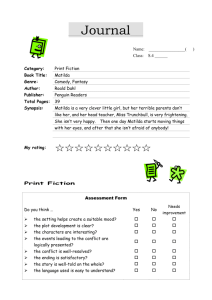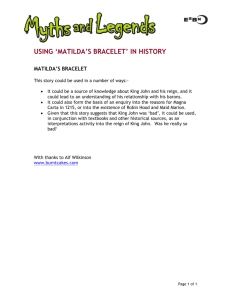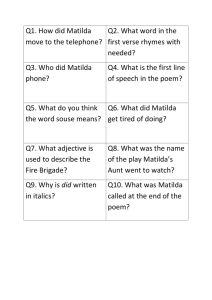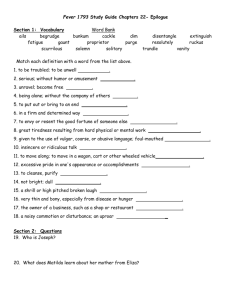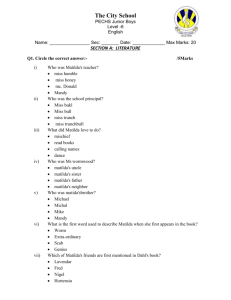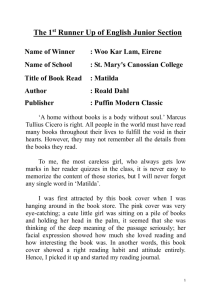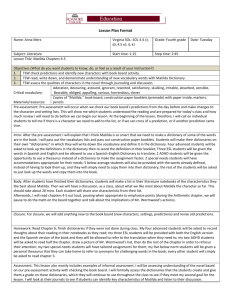Analysis of Matthew G. Lewis*s The Monk
advertisement
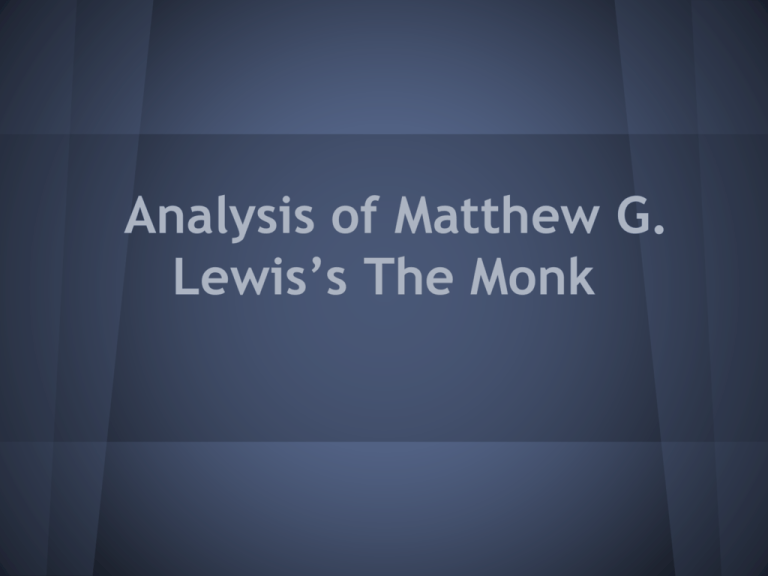
Analysis of Matthew G. Lewis’s The Monk What is the Gothic? • No clear definition exist for it • The importance of atmosphere • • o Medievalesque settings o Haunted Castles - Importance of architecture Heavy Symbolism Psychological aspects Why The Monk? • One of the earliest example of the • • genre (1796) Origin of Gothic conventions Social comments of that time • • Religion Human nature Short Summary of characters • • • • Ambrosio: a monk, tempted by the devil o Pieous Christian; later: rapist and murderer Matilda: seductress, agent of Lucifer o Tempter of Ambrosio Lorenzo and Raymond: cavaliers, o The ‘good guys’ Agnes: nun, lover of Raymond o Damsel in distress Matilda • Name:Gothic origin, meaning ‘brave • in battle’ o Suggests barbaric, pagan connections Two conflicting sides: o Supernatural: manipulative and ruthless o Human: signs of genuine emotion Matilda as a Faustian agent • Like Mephisto in Faust, she is o o o o a companion and adviser a granter of power for servitude a master of human nature manipulative Comparison with Faust: differences Matilda • • Occasionaly genuine emotions Sexual charm o Frees instincts (ID) Mephisto (Faust) • • No genuinity: 100% manipulation Intellectual charm o Frees consciousness (Superego) Archetypes Male Sky (Uranos, Zeus, Thor) Wind and thunder: Action and change • • Female Earth (Gaia, Anann) Nature: Preservation and nurturing • • Archetypes • Conclusion: In the traditions of fiction • • • men act women are acted upon Exception: when women act, it is either o Foolish o Wicked o Or Both Archetypes Male Lorenzo and Christoval: Cavaliers, medievalesque morality Ambrosio: Man of authority, corrupted soul Female Antonia: angelic, innocent and helpless Agnes: passive sufferer Matilda: woman of action, wicked nature • • • • • Ambrosio as a sky god • • • • Strict and erect posture o Like a statue Clear authority, detached worldview o He views himself above ordinary people Voice and oratory described as thundery Calm, but full of destructive potential Motif of Thunder ‚He inveighed against the vices of humanity, and described the punishments reserved for them in a future state. Every Hearer looked back upon his past offences, and trembled: The Thunder seemed to roll...’ ‘His words sounded like thunder to her ears: ‘ ‘As He thundered out these words, He violently grasped Antonia's arm, and spurned the earth with delirious fury.’ Changes in Ambrosio • Matilda seduces him His subconscious is freed • He is drawn to Lucifer • He gains supernatural power, but becomes a slave to it. • He loses the will to make active decisions • He becomes like fire: destructive and ravaging, but controllable Antonia’s rape scene ’The effects which it had already produced permitted not his doubting its success in prolonging the slumbers of his devoted Mistress. No sooner was the enchantment performed than He considered her to be absolutely in his power, and his eyes flamed with lust and impatience.’ Incubus Raymond meets the Bleeding Nun ‘A figure entered, and drew near my Bed with solemn measured steps. With trembling apprehension I examined this midnight Visitor. God Almighty! It was the Bleeding Nun!’ ‘My blood was frozen in my veins. I would have called for aid, but the sound expired ere it could pass my lips. My nerves were bound up in impotence, and I remained in the same attitude inanimate as a Statue. ‘ Sleep Paralysis • State between wakefullness and rest • • Hallucinations, often nightmarish in Muscle weakness, inability to move • nature Cultural connection: visions that are possible sources of legends Reasons of downfall Ambrosio • • • • Indecisive Refuses to escape his situation Integrity crisis: does not seek solution Lose of authority Matilda • • • • Makes plans and schemes She controls what to see (Cavern scene: light carrier) Practicer of witchcraft: evil power Maker of deals Reasons of downfall • Conclusion • • Ambrosio is too passive for a man Matilda is too active for a woman Anti-Catholic themes • Gothic cathedral, Catholic symbol • • • Beacon of light and the heavens; visual appeal But monstrous and sinister at night Metaphor for the Church: extravagant, but corrupt Anti-Catholic themes: Statues Anti-Catholic themes: Statues • ‚Strategically’ placed for the most important scenes • Constant reminders of Catholic Authority • • They are like a ‚divine surveillance system’ Eyes of God or eyes of the Church? • Praying to statues of saints Idolatry, superstition Anti-Catholic themes: Statues ‘A single Lamp, burning before the Statue of St. Rosolia, shed a faint light through the room, and permitted him to examine all the charms of the lovely Object (Antonia) before him.’ 'She started away from the Statue's Pedestal on which She had been seated, and attempted to escape by flight.’ ‚'Then would I vent my anguish in loud exclamations and passionate complaints; and then again my strength failing me, silent and hopeless I would sit me down upon the base of St. Clare's Statue, fold my arms, and abandon myself to sullen despair. ' Conclusion Violation of cultural roles brings pain and death Possible influence os certain archetypes Women are powerless and they are sacrificed Symbolic use of objects Catholicism is sinister and evil The End
